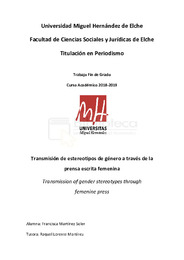Por favor, use este identificador para citar o enlazar este ítem:
https://hdl.handle.net/11000/7613Registro completo de metadatos
| Campo DC | Valor | Lengua/Idioma |
|---|---|---|
| dc.contributor.advisor | Lorente Martínez, Raquel | - |
| dc.contributor.author | Martínez Soler, Francisca | - |
| dc.contributor.other | Departamentos de la UMH::Ciencias Sociales y Humanas | es |
| dc.date.accessioned | 2021-05-05T13:01:40Z | - |
| dc.date.available | 2021-05-05T13:01:40Z | - |
| dc.date.created | 2019-06 | - |
| dc.date.issued | 2021-05-05 | - |
| dc.identifier.uri | http://hdl.handle.net/11000/7613 | - |
| dc.description.abstract | Antecedentes: El papel de los medios de comunicación en la transmisión de estereotipos de género es innegable, influencia que ha sido probada a lo largo de los años a través de diferentes estudios y teorías. La transmisión de estos elementos socializadores crea marcos con ideales que mujeres y hombres se ven presionados a aceptar e integrar en su día a día. Esto es más evidente en la imagen que se proyecta hacia las mujeres, sobre todo en la llamada “prensa femenina”, aquella que está dirigida especialmente a este sexo. Objetivo: estudiar la transmisión de estereotipos de género que tanto la prensa del corazón como la prensa feminista realiza. Método: Se ha realizado un estudio descriptivo mediante análisis de contenido para detectar estereotipos de género en estas dos categorías de revistas femeninas. A través del análisis y estudio de los contenidos de ambas categorías, se ha analizado si son las revistas del corazón las que más estereotipos transmiten o si por el contrario son las feministas. Asimismo, se investigó la imagen de mujer que ambas transmiten. Resultados: En los resultados se observa que las revistas del corazón son las que mayor número de estereotipos transmiten hacia las mujeres, creando así una imagen idealizada difícil de conseguir en su audiencia. Por otra parte, aunque las revistas feministas también transmiten estas imágenes estereotipadas, la diferencia con respecto a las otras revistas es muy notable en cuanto a la cantidad de estereotipos se refiere. También se pudo observar en la transmisión de estereotipos de género de ambas categorías la primacía de la imagen de la mujer como “compañera”, “madre” y “emocional/afectiva”. Conclusiones: La prensa femenina tiene presencia de estereotipos de género que siguen proyectando roles de la mujer tradicionalmente establecidos por la cultura. Se discute las implicaciones de estos resultados en el periodismo desde una perspectiva de género. | es |
| dc.description.abstract | History: the role of the media on the gender stereotypes transmission is undeniable, influence that has been proved through the years thanks to different studies and theories. The transmission of these socializing elements create aspirational frames which women and men seen themselves pushed to accept and incorporate on their daily life. This is more clear on the image that is projected towards women, specially on the feminine press, which is mainly directed to this sex. Goals: tried to study the gender stereotypes transmission inside gossip magazines and feminist’s ones. Method: it has been done a descriptive study by analyzing the content to detect gender stereotypes into these two magazine categories. Through an analysis and study of the contents that both publications gather, it has been analysed if the gossip magazines are the ones that carry the most stereotypes, or on the other hand, if the feminist’s are the ones. Additionally, the women image that both notify it had been considered as well. Results: on the results can be seen it has been determined that the gossip magazines are the ones that share the most stereotypes directed to women, by creating this way an idealised image hard to accomplish. On the other hand, even though the feminist’s magazines share these kind of elements too, the difference among their competitors it is noticeable. Also it could be seen on the transmission of gender stereotypes of both magazine categories the primacy of the image of the women as “partner”, “mother” and “emotional/affective”. Conclusion: the feminine press shows gender stereotypes presence, that keeps portraying feminine culture roles established by the culture. This study talks about the influence of the results on the journalism by a gender perspective. | es |
| dc.format | application/pdf | es |
| dc.format.extent | 43 | es |
| dc.language.iso | spa | es |
| dc.rights | info:eu-repo/semantics/openAccess | es |
| dc.subject | estereotipo | es |
| dc.subject | stereotype | es |
| dc.subject | género | es |
| dc.subject | revistas femeninas | es |
| dc.subject | revistas del corazón | es |
| dc.subject | revistas feministas | es |
| dc.subject | gender | es |
| dc.subject | feminine magazines | es |
| dc.subject | gossip magazines | es |
| dc.subject | feminist’s magazines | es |
| dc.subject.other | CDU::0 - Generalidades.::070 - Periódicos. Prensa. Periodismo. Ciencias de la información | es |
| dc.title | Transmisión de estereotipos de género a través de la prensa escrita femenina | es |
| dc.title.alternative | Transmission of gender stereotypes through femenine press | es |
| dc.type | info:eu-repo/semantics/bachelorThesis | es |

Ver/Abrir:
PER_TFG_MARTÍNEZ_SOLER_FRANCISCA (03).pdf
1,13 MB
Adobe PDF
Compartir:
 La licencia se describe como: Atribución-NonComercial-NoDerivada 4.0 Internacional.
La licencia se describe como: Atribución-NonComercial-NoDerivada 4.0 Internacional.
.png)